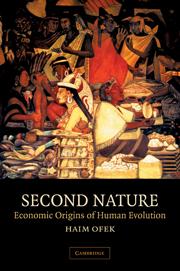Book contents
- Frontmatter
- Contents
- Acknowledgments
- 1 Introduction
- Part 1 Bioeconomics
- 2 Exchange in human and nonhuman societies
- 3 Classical economics and classical Darwinism
- 4 Evolutionary implications of division of labor
- 5 The feeding ecology
- 6 The origins of nepotistic exchange
- 7 Baboon speciation versus human specialization
- Part 2 Paleoeconomics
- References
- Index
6 - The origins of nepotistic exchange
Published online by Cambridge University Press: 06 July 2010
- Frontmatter
- Contents
- Acknowledgments
- 1 Introduction
- Part 1 Bioeconomics
- 2 Exchange in human and nonhuman societies
- 3 Classical economics and classical Darwinism
- 4 Evolutionary implications of division of labor
- 5 The feeding ecology
- 6 The origins of nepotistic exchange
- 7 Baboon speciation versus human specialization
- Part 2 Paleoeconomics
- References
- Index
Summary
Without really being aware of it, human beings economically interact under two distinct routines – nepotistic exchange and market exchange – effortlessly switching back and forth between the two regimes. The tendency to turn on and off two separate processes of decision-making (with implications in action and in demeanor) could have been readily diagnosed as some sort of split-personality disorder had it not been so predictable – repeating itself in nearly the same manner in almost any member of the species. The fundamental difference between the market and the nepotistic (or domestic) routines of human activities was examined in the foregoing discussion (especially in Chapter 2) on the grounds of practical considerations and, so far, only with a secondary emphasis on evolutionary ones. The main implication suggests nothing in the way of a behavioral disorder. What it suggests is the coexistence of two distinct adaptations. The main attempts to trace these two adaptations to their separate evolutionary origins are relegated to two chapters in this volume. The present chapter is primarily concerned with the origins of nepotistic exchange. (Chapter 9 will be similarly concerned with the origins of market exchange.)
Primordial exchange at the lowest levels of organization
Certain advantages of division of labor, supported by exchange, occurred at fairly early stages of life on earth. Consider, for instance, the evolution of one of the most comprehensive and amazing systems of exchange and division of labor in nature: a single body of a multicelled organism. Finely tuned exchange among specialized cells, tissues, and organs is inherent in the physiology of such an organism.
- Type
- Chapter
- Information
- Second NatureEconomic Origins of Human Evolution, pp. 84 - 104Publisher: Cambridge University PressPrint publication year: 2001

